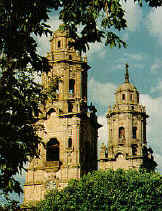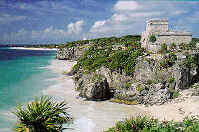![]()

The Yucatan
Both physically and historically, the three states that comprise the Yucatan
peninsula - Campeche, Yucatan and Quintana Roo -are distinct from the rest of
Mexico. The interminably flat, low-lying plain is one of the hottest and most
tropical-feeling areas of the country, but in fact it lies farther north than
you might imagine - Merida is actually north of Mexico. Until the 1960s, when
proper road and train links were completed, the Yucatan lived out of step with
the rest of Mexico - there was almost as much contact with Europe and the United
States as with the center. Now tourism has made major inroads, especially in
the north around the great Maya sites and on the route from Menda to the "super-resort"
of Cancun, and new investment has brought it closer to the heart of things.
But a unique character remains, and in the south, where townships are sparsely
scattered in thick, jungly forest, there's still a distinct pioneering feel.
The modern boom is, in fact, a re-awakening, for this has been the longest continuously
civilized part of the country, with evidence of Maya inhabitants as early as
2500 BC, producing good pottery and living in huts virtually identical to those
you see in the villages today. The Maya are not a specifically Mexican culture
- their greatest cities, indeed, were not in Mexico at all but in the lowlands
of modern Guatemala, Belize and Honduras - but they did produce a unique style
in the Yucatan and continued to flourish here long after the collapse of the
"Classic" civilizations to the south. This they did in spite of natural
handicaps - thin soil, heat, humidity and lack of water - and in the face of
frequent invasion from central Mexico. And here the Maya peasantry still live,
remarkably true to their old traditions and lifestyle, despite the hardships
of the intervening years: ravaged by European diseases and forced to work on
vast colonial encomiendas, or later, through the semi-slavery of debt peonage,
on the henequen plantations or in the forests, hauling timber.
The florescence of Maya culture, throughout their extensive domains, came in
the Classic period from around 300 to 900 AD: an age in which the cities grew
up and Maya science and art apparently reached their height. The Maya calendar,
a complex interaction of solar, astronomical and religious dates, was far more
complicated and accurate than the Gregorian one, and they also developed a sophisticated
mathematical and (still largely undeciphered) hieroglyphic system. In the ninth
century, though, the major cities were gradually abandoned - the result perhaps
of revolt by a population from whom the elite had become too remote, their knowledge
too arcane, and provoked by some natural disaster. Whatever the reason, in Guatemala
and Honduras the sites were never to be repopulated. In the Yucatan the abandonment
was less total, and in many places short-lived. Instead there was a renaissance
stimulated by contact with central Mexico: initially perhaps through trade,
later by a direct Toltec invasion. A new society sprang up that fused the Toltec
emphasis on militarism, and new gods, with Maya traditions. Its ultimate achievement
was at Chichen Itza', dominant until the twelfth century.
From the twelfth century on, Mayapan became the new center of power, controlling
the entire peninsula in an era when artistic and architectural standards went
into sharp decline. By the time the Spanish arrived Mayapan's power, too, had
been broken by revolt and the Maya had splintered into tribalism - although
still with coastal cities and long-distance sea trade that awed the Conquistadors.
It proved the hardest area of the country to pacify. Despite attempts to destroy
all trace of the ancient culture, there was constant armed rebellion against
the Spanish and later the Mexican authorities - the last the Caste Wars of the
19th century, during which the Maya, supplied with arms from British Honduras,
gained brief control of the entire peninsula. Gradually, though, they were again
pushed back into the wastes of southern Quintana Roo, where the final pockets
of resistance held out until the beginning of this century.
Travel Details
Buses
There aren't many places that you can't get to by bus on the peninsula. Sometimes
the time-tabling isn't totally convenient but the service is generally efficient.
The most useful services are between Merida and Cancun and those provided by
lnterplaya, which run at least every thirty minutes between Cancun, and Tulum.
Some places aren't served by first-class buses, but second-class buses and combis
will get you around locally and to the nearest major center. Such places include:
Oxkutzcab, Progreso, Ticul and Tizimin. The following frequencies and times
are for first-class services. Second-class buses usually cover the same routes
running 10-20 percent slower.
Campeche to: Cancun (1 daily; 8hr); Chetumal (1 daily; 6hr); Ciudad del
Carmen (5 daily; 2hr 30 minutes); Cordoba (3 daily; 1 2hr); Escarcega (1 daily;
2hr); Merida (every 30 minutes; 3-4hr)); Mexico (3 daily; 22hr+); Palenque (2
daily; 5hr); San Crist6bal de las Casas (1 daily; l0hr); Villahermosa (5 daily;
6hr).
Cancun to: Campeche (1 daily; 8hr); Chetumal (5 daily; 6hr); Merida (frequently;
5-6hr); Mexico (1 daily; 30hr+); Playa del Carmen (frequently; lhr); Puerto
Morelos (at least every 30 minutes; lhr); Tizimin (3 daily; 3hr); Tulum (at
least every 30 minutes; 2hr); Valladolid (6 daily; 2hr); Villahermosa (1 daily;
14hr).
Chetumal to: Campeche (1 daily; 6hr); Cancun (5 daily; 6hr); Merida (7
daily; 9hr); Playa del Carmen (5 daily; 5-8hr); Tulum (6 daily; 4-5hr); Valladolid
(3 daily; 5hr).
Merida to: Campeche (every 30 minutes; 3-4hr); Cancun (frequently; 5-6hr);
Chetumal (7 daily; 9hr); Mexico (6 daily; 28hr+); Palenque (2 daily; 10-1 lhr);
Playa del Carmen (7 daily; 8hr); Progreso (frequently; 45 minutes); Tizimin
(3 daily; 4hr); Tulum (3 daily; 6hr); Uxmal (13 daily; 2hr); Valladolid (hourly;
3hr); Villahermosa (6 daily; lOhr).
Playa del Carmen to: Cancun (frequently; lhr); Chetumal (5 daily; 5-8hr);
Coba (3 daily; 2hr); Merida (7 daily; 8hr); Mexico (3 daily; 30hr+); Palenque
(1 daily; 12hr); San Crist6bal de las Casas (1 daily; l4hr); Tulum (frequently;
lhr); Tuxtla Gutierrez (1 daily; 16hr); Valladolid (3 daily; 4hr); Villahermosa
(4 daily; 13hr).
Tizimin to: Merida (3 daily; 4hr); Rio Lagartos (5 daily; 1 hr); Valladolid
(hourly; lhr).
Tulum to: Cancun (at least every 30 minutes; 2hr); Chetumal (6 daily;
4-Shr); Coba (3 daily; lhr); Merida (3 daily; 6hr); Playa del Carmen (frequently;
1hr); Valladolid (2 daily; 4hr).
Valladolid to: Cancun (6 daily; 2hr); Chetumal (3 daily; 5hr); Coba (2
daily; 2hr); Merida (hourly; 3hr); Playa del Carmen (3 daily; 4hr); Tizimin
(hourly; lhr); Tulum (2 daily; 4hr).
Planes
Merida, Cancun and Cozumel all have busy international airports with several
daily flights to Mexico and regular connections to Miami and many other cities
in the southern United States. Campeche and Chetumal also have daily direct
services to Mexico. Around the Caribbean coast various small companies fly light
planes - very frequently between Cancun and Cozumel, less often from these places
to Isla Mujeres, Playa del Carmen and Tulum.
Ferries
There are frequent competitive ferry services to Isla Mujeres and Cozumel. On
both routes there is a choice between a low-cost slow boat or a more luxurious
fast boat, which generally halves the crossing time. Although there is a car
ferry to Isla Mujeres, it is hardly worth taking a vehicle over as the island
is so small.
Passenger Ferries
Chiquila' to: Isla Holbox (2 daily; lhr).
Playa del Carmen to: Cozumel (every 1 -2hr; 30 minutes- lhr).
Punta Jua'rez to: Isla Mujeres (every 30 minutes; 15-30 minutes).
Car Ferries
Chiquila' to: Isla Holbox (1 daily, except Thurs & Sun; lhr).
Puerto Morelos to: Cozumel (1 daily, 2 on Mon; 2hr 30 minutes).
Punta Sam to: Isla Mujeres (6 daily).
The Yucatan Peninsula embraces the best of both worlds, the shimmering turqouise waters and unspoiled beaches, to the ancient Mayan ruins dating back from pre Columbus time. The striking combination appeals to visitors with varios budgets, time limits and vacation needs. The Cancun/Tulum sun coast is a 100 mile corridor of dazzling Caribbean coastline containing secluded beaches and coves, quaint fishing villages and ancient Mayan ruins. Visiting these smaller, less developed sun coast cities is a far cry from the fast paced hussle and bussle of Cancun. Playacar, Puerto Aventuras, Akumal, Costa Turquesa and Tulum all have a unique identity of thier own, and can be easily visited by car or guided motor coach tour from Cancun. You can even take a ferry to Isla Mujeres (Island fo women), for a tropical diving adventure, or visit the Mayan ruins on its southern tip.
be it a sleepy native village, a tranquil seaside retreat, a secluded island paradise or a mysterious Mayan temple, you can explore it all on the beautiful, sunny Yucatan Peninsula.

![]()
![]()